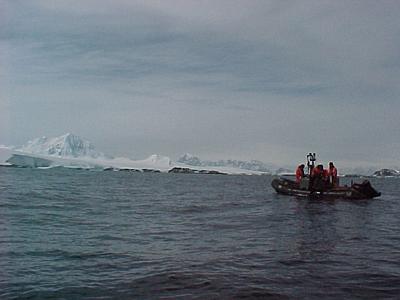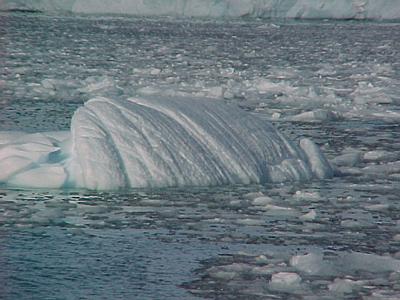5 December, 2000
Greetings,
I was sent a series of questions from Mrs. Smith's 6th grade class in Santa
Barbara, California. I wish them all well with their studies. They have a
great teacher.
1. How do you deal with the cold in the Antarctic, and how cold is it really?
The temperature at Palmer since I have been here has been between about -2
and 3 degrees Celsius. That would be between 25-35 degrees Fahrenheit.
Since we are located on the ocean our temperature stays fairly constant,
but we do get significant winds. Wind chill factor is a measure of how
quickly your body loses heat. It feels much colder. When we arrive in Punta
Arenas they assign us 35 pounds of cold weather clothing. The important
thing is to wear layers of clothing because the weather changes quickly.
2. Can scientists go on icebergs? If they do, what safety precautions do
they take? How come icebergs are so powerful (dangerous)?
Scientist can only go on some icebergs safely. Icebergs melt as they are
moving around the ocean. This makes them unstable. They could turtle.
Meaning that it could flip over. Others could split apart or break off into
smaller pieces. Some icebergs are very large. There is one iceberg that
broke off last March that scientists are tracking. At one point it was as
big as the state of Connecticut. Scientist plan on placing equipment on the
iceberg so that can track its movements. Here at Palmer we cannot get any
closer than 3 times the height of the iceberg. It is a good rule because
the water temperature is so cold you would only survive a few minutes in
the freezing water.
3. What are the highest waves happening in the Drake, and what were the
waves you encountered?
The highest waves I encountered on my crossing were between 10 to 15 feet
high. During a typical storm through the drake waves can be between 20 and
30 feet high. I was told that in 1988 The Polar Duke was crossing the Drake
Passage and got hit by a wave that blew out the windows in the bridge. The
bridge is 50 feet high.
4. What other animals besides penguins and seals can you see and observe?
I have seen the following birds; Brown Skuas, Giant Southern Petrels,
Antarctic Terns, Kelp Gulls and Sheathbills. I have also observed Minke
Whales, Krill, fish and other benthic creatures (creatures that live on the
ocean floor).
5. How many types of penguins are there? Which are your favorite and why?
Do you see them often? What do they eat and do?
There are three types of penguins around Palmer, Adelie, Gentoo and
Chinstrap. I see penguins everyday. Quite often they come up to within 15
feet of station. Today there were a group of three Adelies they stopped by.
The day before that it was Gentoos. I'm sure many more come around that I
don't see because I'm working. I like all the penguins. They make such
interesting noises and I like the way they clumsily move on land and are so
agile in the water. The penguins main food source is krill but occasionally
eat other things. The penguins I have seen spend time sharing the duty of
keeping the egg warm and fighting over pebbles.
6. How small are penguins when they are born? Are you going to see them
being born?
Penguins are about 4 inches tall. The eggs are a little bit larger than a
chicken egg. The Adelie's eggs should be hatching over the next two weeks.
I hope to get to see them hatch and send back pictures.
7. What made you want to go to the Antarctic?
I decided to go to Antarctica because it is one of the few pristine places
on earth. It would also give me a chance to work with scientists and see
firsthand the science that is taking place. It would allow me to take back
tools and information to my classroom and make me a better teacher.
8. Did you rub the foot of Magellan's sailor before you left? Did it work?
There is a statue of Magellan in Punta Arenas. They say that if you rub his
foot you will have a safe ride across the Drake. I could tell many people
ahead of me have rubbed that foot. It worked great because I made it
safely to Palmer Station.
I have to go now but make sure you stop by tomorrow. I promise you won't
want to miss the incredible story of the ice fish and details of toady's
work. Pictures included!
Talk to you later (ttyl),
-- Bill

A great reason to be in Antarctica. There is a great view.

This is an iceberg that has turtled more than once. You can see where it has been carved up by rocks that has now flipped to the top.
Contact the TEA in the field at
.
If you cannot connect through your browser, copy the
TEA's e-mail address in the "To:" line of
your favorite e-mail package.
|
